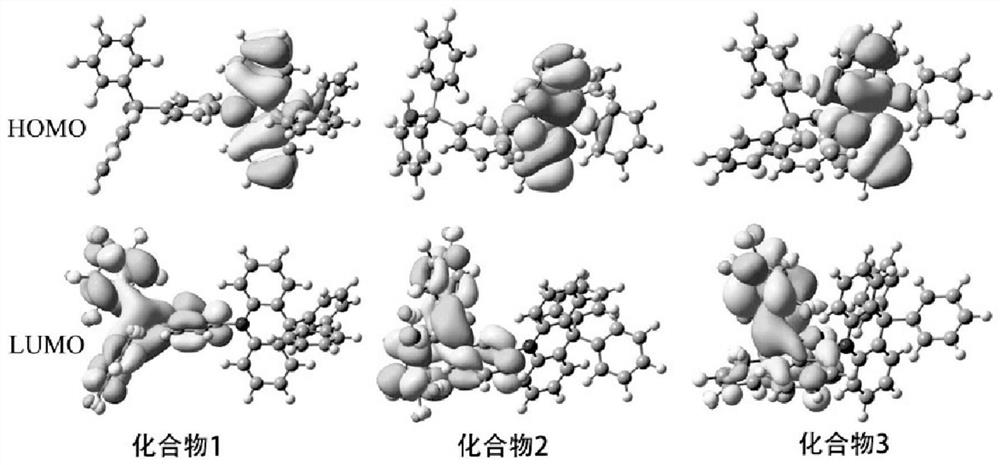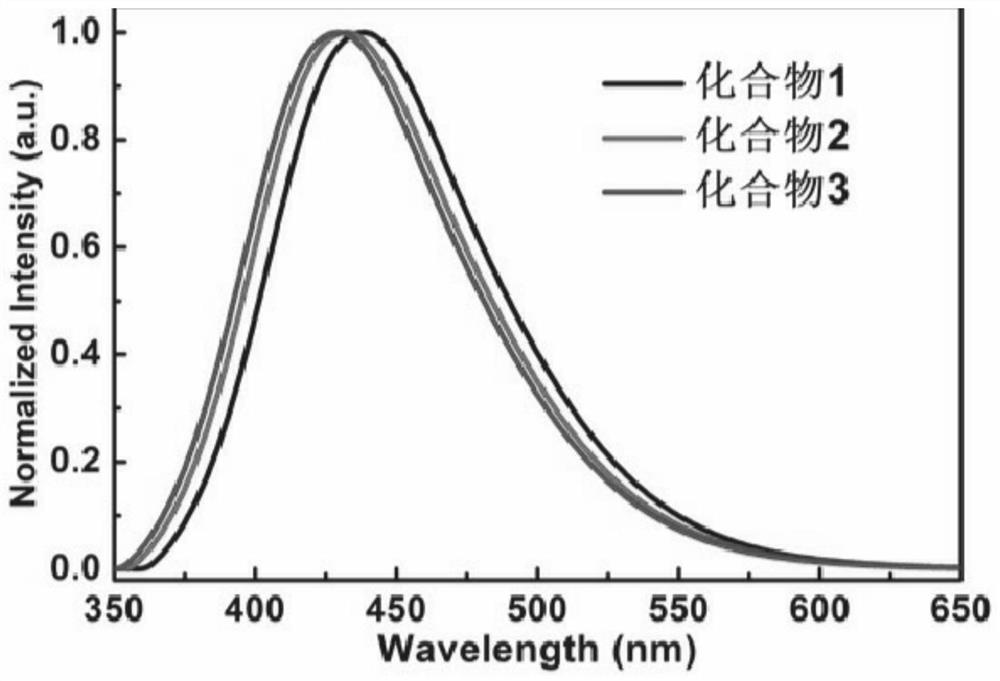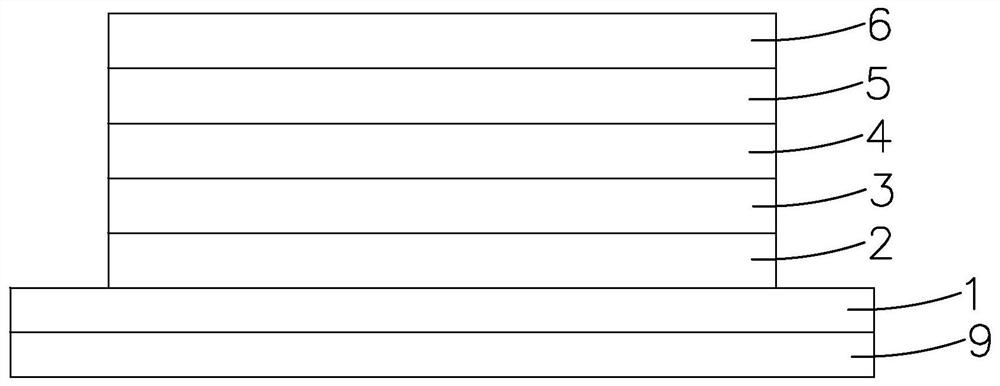Thermally activated delayed fluorescent material and preparation method thereof and organic electroluminescent diode device
A technology of heat-activated delay and fluorescent materials, which is applied in the direction of luminescent materials, electric solid devices, chemical instruments and methods, etc., can solve the problems of limited applications, and achieve the effects of poor color gamut, high yield and high device efficiency
- Summary
- Abstract
- Description
- Claims
- Application Information
AI Technical Summary
Problems solved by technology
Method used
Image
Examples
Embodiment 1
[0044] The synthetic route of target compound 1 is as follows:
[0045]
[0046] Add raw material 1 (2.68g, 5mmol), 9,10-dihydro-9,9-diphenylacridine (2.00g, 6mmol), palladium acetate Pb (OAc) (45mg, 0.2mmol) in 100mL two-necked flask ) and tri-tert-butylphosphine tetrafluoroborate (t-Bu) 3 HPBF 4 (0.17g, 0.6mmol), then add sodium tert-butoxide NaOt-Bu (0.58g, 6mmol) in the glove box, inject 40mL of toluene that has been dehydrated and deoxygenated in advance under an argon atmosphere, and react at 120°C for 24 hours . Cool to room temperature, pour the reaction solution into 200 mL of ice water, extract three times with dichloromethane, combine the organic phases, spin into silica gel, and separate and purify by column chromatography (dichloromethane:n-hexane, v:v, 3:1) to obtain 2.0 g of compound 1 as blue-white powder, yield 51%.
[0047] 1HNMR (300MHz, CD 2 Cl 2 ,δ): 7.73 (d, J=6.3Hz, 2H), 7.38 (d, J=6.9Hz, 2H), 7.26-7.07 (m, 14H), 6.95-6.83 (m, 4H).
[0048]MS(E...
Embodiment 2
[0050] The synthetic route of target compound 2 is as follows:
[0051]
[0052] Add raw material 2 (2.68g, 5mmol), 9,10-dihydro-9,9-diphenylacridine (2.00g, 6mmol), palladium acetate (45mg, 0.2mmol) and three tert-tert Butylphosphine tetrafluoroborate (0.17g, 0.6mmol), then sodium tert-butoxide (0.58g, 6mmol) was added in the glove box, and 40mL of toluene, which had been dehydrated and deoxygenated in advance, was injected under an argon atmosphere. React at 120°C for 24 hours. Cool to room temperature, pour the reaction solution into 200 mL of ice water, extract three times with dichloromethane, combine the organic phases, spin into silica gel, and separate and purify by column chromatography (dichloromethane:n-hexane, v:v, 3:1) to obtain 1.6 g of compound 2 as blue-white powder, yield 41%.
[0053] 1 H NMR (300MHz, CD 2 Cl 2 ,δ): 7.57 (s, 1H), 7.43-7.33 (m, 3H), 7.26-7.07 (m, 14H), 6.95-6.83 (m, 4H).
[0054] MS(EI)m / z:[M] + calcd for C 43 h 22 f 10 NOP, 789.1...
Embodiment 3
[0056] The synthetic route of target compound 3 is as follows:
[0057]
[0058] Add raw material 3 (2.68g, 5mmol), 9,10-dihydro-9,9-diphenylacridine (2.00g, 6mmol), palladium acetate (45mg, 0.2mmol) and three tert-tert Butylphosphine tetrafluoroborate (0.17g, 0.6mmol), then sodium tert-butoxide (0.58g, 6mmol) was added in the glove box, and 40mL of toluene, which had been dehydrated and deoxygenated in advance, was injected under an argon atmosphere. React at 120°C for 24 hours. Cool to room temperature, pour the reaction solution into 200 mL of ice water, extract three times with dichloromethane, combine the organic phases, spin into silica gel, and separate and purify by column chromatography (dichloromethane:n-hexane, v:v, 3:1) to obtain 1.0 g of compound 3 as blue-white powder, yield 25%.
[0059] 1 H NMR (300MHz, CD 2 Cl 2 ,δ):7.73(d,J=6.9Hz,1H),7.54-7.38(m,2H),7.32(d,J=6.3Hz,1H),7.26-7.07(m,14H),6.95-6.83( m, 4H).
[0060] MS(EI)m / z:[M] + calcd for C 43 h 2...
PUM
 Login to View More
Login to View More Abstract
Description
Claims
Application Information
 Login to View More
Login to View More - R&D
- Intellectual Property
- Life Sciences
- Materials
- Tech Scout
- Unparalleled Data Quality
- Higher Quality Content
- 60% Fewer Hallucinations
Browse by: Latest US Patents, China's latest patents, Technical Efficacy Thesaurus, Application Domain, Technology Topic, Popular Technical Reports.
© 2025 PatSnap. All rights reserved.Legal|Privacy policy|Modern Slavery Act Transparency Statement|Sitemap|About US| Contact US: help@patsnap.com



